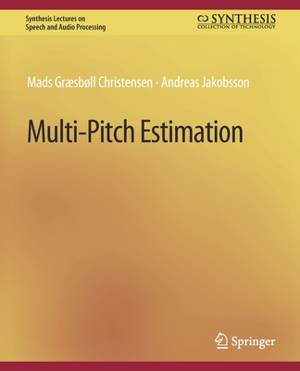
Je cadeautjes zeker op tijd in huis hebben voor de feestdagen? Kom langs in onze winkels en vind het perfecte geschenk!
- Afhalen na 1 uur in een winkel met voorraad
- Gratis thuislevering in België vanaf € 30
- Ruim aanbod met 7 miljoen producten
Je cadeautjes zeker op tijd in huis hebben voor de feestdagen? Kom langs in onze winkels en vind het perfecte geschenk!
- Afhalen na 1 uur in een winkel met voorraad
- Gratis thuislevering in België vanaf € 30
- Ruim aanbod met 7 miljoen producten
Zoeken
Omschrijving
Periodic signals can be decomposed into sets of sinusoids having frequencies that are integer multiples of a fundamental frequency. The problem of finding such fundamental frequencies from noisy observations is important in many speech and audio applications, where it is commonly referred to as pitch estimation. These applications include analysis, compression, separation, enhancement, automatic transcription and many more. In this book, an introduction to pitch estimation is given and a number of statistical methods for pitch estimation are presented. The basic signal models and associated estimation theoretical bounds are introduced, and the properties of speech and audio signals are discussed and illustrated. The presented methods include both single- and multi-pitch estimators based on statistical approaches, like maximum likelihood and maximum a posteriori methods, filtering methods based on both static and optimal adaptive designs, and subspace methods based on the principles of subspace orthogonality and shift-invariance. The application of these methods to analysis of speech and audio signals is demonstrated using both real and synthetic signals, and their performance is assessed under various conditions and their properties discussed. Finally, the estimators are compared in terms of computational and statistical efficiency, generalizability and robustness. Table of Contents: Fundamentals / Statistical Methods / Filtering Methods / Subspace Methods / Amplitude Estimation
Specificaties
Betrokkenen
- Auteur(s):
- Uitgeverij:
Inhoud
- Aantal bladzijden:
- 141
- Taal:
- Engels
- Reeks:
Eigenschappen
- Productcode (EAN):
- 9783031014307
- Verschijningsdatum:
- 2/03/2009
- Uitvoering:
- Paperback
- Formaat:
- Trade paperback (VS)
- Afmetingen:
- 190 mm x 235 mm
- Gewicht:
- 285 g

Alleen bij Standaard Boekhandel
+ 70 punten op je klantenkaart van Standaard Boekhandel
Beoordelingen
We publiceren alleen reviews die voldoen aan de voorwaarden voor reviews. Bekijk onze voorwaarden voor reviews.









